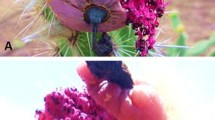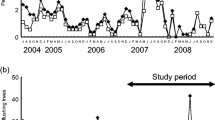Abstract
Although it is an anatomical folivore, the diet of the Milne-Edwards’ sifaka (Propithecus diadema edwardsiA. Grandidier, 1871) in Ranomafana National Park contained 35% seeds, 30% whole fruit, and 28% leaves. Plant species used as seed sources differed from those used as whole fruit sources in terms of temporal variation in consumption, taxonomic affiliation, morphology, and phenology. Although seeds were destroyed in both exploitation styles used by the sifakas—seed and whole fruit-eating—the gross morphology of species used as seed sources conformed to the complex of traits typical for fruits experiencing seed predation, while species used as whole fruit sources conformed to traits typical for fruits that do not experience predispersal predation. Many of the 19 plant species from which the seed was extracted and eaten contained a single seed with moderate testa thickness, and fruits containing this type of seed were medium-sized with dry or fibrous flesh, moderate skin thickness, and a dull color. In contrast, brightly colored, juicy fruits with minimally protected seeds were characteristic of the 38 plant species from which both pericarp and seed were eaten. Compared to transectwide measures of fruit availability or patterns restricted to whole fruit sources, fewer species of seed sources produced fruit per month and fruiting activity was more seasonal.
Similar content being viewed by others

References
Altmann, J. (1974). Observational study of behavior: Sampling methods.Behaviour 49: 227–265.
Bauchop, T., and Martucci, R. W. (1968). Ruminant-like digestion of the langur monkey.Science 161: 689–700.
Bremer, B., and Eriksson, O. (1992). Evolution of fruit characters and dispersal modes in the tropical family Rubiaceae.Biol. J. Linn. Soc. 47: 79–95.
Chivers, D. J. (1994). Functional anatomy of the gastrointestinal tract. In Davies, A. G., and Oates, J. F. (eds.),Colobine Monkeys: Their Ecology, Behavior, and Evolution, Cambridge University Press, Cambridge, pp. 205–228.
Chivers, D. J., and Hladik, C. M. (1980). Morphology of the gastrointestinal tract on primates: Comparisons with other mammals in relation to diet.J. Morphol. 166: 337–386.
Dasilva, G. L. (1994). Diet ofColobus polykomos on Tiwai Island: Selection of food in relation to its seasonal abundance and nutritional quality.Int. J. Primatol. 15: 655–680.
Davies, G. (1991). Seed-eating by red leaf monkeys (Presbytis rubicunda) in dipertocarp forest of northern Borneo.Int. J. Primatol. 12: 119–144.
Davies, A. G., and Oates, J. F. (eds.) (1994).Colobine Monkeys: Their Ecology, Behavior, and Evolution, Cambridge University Press, Cambridge
Davies, A. G., Bennett, E. L., and Waterman, P. G. (1988). Food selection by two South-East Asian colobine monkeys. (Presbytis rubicunda andP. melalophos) in relation to plant chemistry.Biol. J. Linn. Soc. 34: 33–56.
Fischer, K. E., and Chapman, C. A. (1993). Fruigvores and fruit syndromes: Differences in patterns at the genus and species level.Oikos 66: 472–482.
Garber, P.A. (1987). Foraging strategies among living primates.Annu. Rev. Anthropol. 16: 339–364.
Ganzhorn, J. U. (1988). Food partitioning among Malagasy primates.Oecologia 75: 436–450.
Ganzhorn, J. U. (1989). Primate species separation in relation to secondary compounds.J. Hum. Evol. 4: 125–132.
Ganzhorn, J. U. (1992). Leaf chemistry and the biomass of folivorous primates in tropical forests.Oecologia 91: 540–547.
Ganzhorn, J. U., Abram, J. P., and Razanahoera-Rakotomalala, M. (1985). Some aspects of the natural history and food selectionof Avahi laniger.Primates 26: 452–463.
Gautier-Hion, A. (1990). Interactions among fruit and vertebrate fruit-eaters in an African tropical rain forest. In Bawa, K. S. and Hadley, M. (eds.),Reproductive Ecology of Tropical Forest Plants, UNESCO, Paris, pp. 219–230.
Gautier-Hion, A., Duplantier, J.-M., Quirs, R., Feer, F., Sourd, C., Decoux, J.-P., Dubost, G., Emmons, L., Erard, C., Heckseilere, P., Moungazi, A., Roussihon, C., and Thoillay, J.-M. (1985). Fruit characters as a basis of fruit choice and seed dispersal in a tropical forest vertebrate community.Oecologia 65: 324–337.
Gautier-Hion, A., Gautier, J.-P., and Maiseis, F. (1993). Seed dispersal versus predation: An intersite comparison of two related African monkeys.Vegetatio 107: 237–244.
Glander, K. E. (1982). The impact of plant secondary compounds on primate feeding behavior.Yearbk. Phys. Anthropol. 25: 1–18.
Godfrey, L. R., Jungers, W. L., Reed, K. E., and Simons, E. L. (1995). Primate subfossils: Inferences about past and present primate community structure. In Patterson, B. D., Goodman, S. M., and Sedlock, J. L. (eds.),Environmental Change in Madagascar, The Field Museum, Chicago, pp. 16–17.
Harcourt, C. S. (1991). Diet and behaviour of a nocturnal lemur,Avahi laniger, in the wild.J. Zool. London 223: 667–674.
Harrison, M. J. S. (1986). Feeding ecology of black colobus,Colobus satanus, in central Gabon. In Lee, P. C., and Else, J. G. (eds.),Primate Ecology and Conservation, Cambridge University Press, Cambridge, pp. 31–37.
Hemingway, C. A. (1995a).Feeding and Reproductive Strategies of the Milne-Edwards’ sifaka, Propithecus diadema edwardsi. Ph.D. dissertation, Duke University, Durham, NC.
Hemingway, C. A. (1995b). Feeding patterns ofPropithecus diadema edwardsi in relation to forest composition and food availability. In Patterson, B. D., Goodman, S. M., and Sedlock, J. L. (eds.),Environmental Change in Madagascar, The Field Museum, Chicago, p. 24.
Herrera, C. M. (1985). Determinants of plant-animal coevolution: The case of mutualistic dispersal of seeds by vertebrates.Oikos 44: 132–141.
Herrera, C. M. (1995). Plant-vertebrate seed dispersal systems in the Mediterranean: Ecological, evolutionary, and historical determinants.Annu. Rev. Ecol. Syst. 26: 705–728.
Hill, W. C. O. (1953).Primates: Comparative Anatomy and Taxonomy I. Strepsirhini, The University Press, Edinburgh.
Howe, H. H. (1986). Seed dispersal by fruit-eating birds and mammals. In Murray, D. R. (ed.),Seed Dispersal, Academic Press, New York, pp. 123–189.
Izawa, K., and Mizuno, A. (1977). Palm-fruit cracking behavior of wild black-capped capuchin (Cebus apella).Primates 18: 773–792.
Janson, C. H. (1983). Adaptation of fruit morphology to dispersal agents in a neotropical forest.Science 219: 187–189.
Janzen, D. H. (1971). Seed predation by animals.Annu. Rev. Ecol. Syst. 2: 465–492.
Kay, R. F. (1975). The functional adaptations of primate molar teeth.Am. J. Phys. Anthropol. 46: 327–52.
Kay, R. N. B., and Davies, A. G. (1994). Digestive physiology. In Davies, A. G., and Oates, J. F. (eds.),Colobine Monkeys: Their Ecology, Behavior, and Evolution, Cambridge University Press, Cambridge, pp. 229–250.
Kinzey, W. G., and Norconk, M. A. (1993). Physical and chemical properties of fruit and seeds eaten byPithecia andChiropotes in Surinam and Venezuela.Int. J. Primatol. 14: 207–228.
Leighton, M. (1993). Modeling dietary selectivity by orangutans: Evidence for integration of multiple criteria in fruit selection.Int. J. Primatol. 14: 257–314.
Leighton, M., and Leighton, D. R. (1983). Vertebrate responses to fruiting seasonally within a rain forest. In Sutton, S. L., Whitmore, T. C., and Chadwick, A. C. (eds.),Tropical Rain Forest: Ecology and Resource Management, Blackwell Scientific, Oxford, pp. 181–196.
Lucas, P. W., and Teaford, M. F. (1994). Functional morphology of colobine teeth. In Davies, A. G., and Oates, J. F. (eds.),Colobine Monkeys: Their Ecology, Behavior, and Evolution, Cambridge University Press, Cambridge, pp. 173–204.
Maiseis F., Gautier-Hion, A., and Gautier, J.-P. (1994). Diets of two sympatric colobines in Zaire: More evidence on seed-eating in forests on poor soil.Int. J. Primatol. 15: 681–701.
McKey, D. G. (1978). Soils, vegetation, and seed-eating by black colobus monkeys. In Montgomery, G. G. (ed.),The Ecology of Arboreal Folivores, Smithsonian Institution, Washington, DC., pp. 423–437.
McKey, D. B., Waterman, P. G., Mbi, C. N., Gartlan, J. S., and Struhsaker, T. T. (1978). Phenolic content of vegetation in two African rain forests: Ecological implications.Science 202: 61–64.
Meyers, D. M. (1993).The Effects of Resource Seasonality on Behavior and Reproduction in the Golden-Crowned Sifaka (Propithecus tattersalli, Simons, 1988) in Three Malagasy Forests, Ph.D. dissertation, Duke University, Durham, NC.
Meyers, D. M., and Wright, P. C. (1993). Resource tracking: Food availability andPropithecus seasonal reproduction. In Kappeler, P. M., and Ganzhorn, J. U. (eds.),Lemur Social Systems and Their Ecological Basis, Plenum Press, New York, pp. 179–192.
Oates, J. F. (1988). The diet of the olive colobus monkey,Procolobus vents, in Sierra Leone.Int. J. Primatol. 9: 457–478.
Oates, J. F., Waterman, P. G., and Choo, G. M. (1980). Food selection by the south Indian leaf-monkey,Presbytis johnii, in relation to leaf chemistry.Oecologia 45: 45–56.
Overdorff, D. J. (1993). Ecological and reproductive correlates to range use in red-bellied lemurs (Eulemur rubriventer) and rufous lemurs (Eulemur fulvus rufus). In Rappeler, P. M., and Ganzhorn, J. U. (eds.),Lemur Social Systems and Their Ecological Basis, Plenum Press, New York, pp. 167–178.
Parra, R. (1978). Comparison of foregut and hindgut fermentation in herbivores. In Montgomery, G. G. (ed.),The Ecology of Arboreal Folivores, Smithsonian Institution Press, Washington, DC., pp. 205–229.
Peres, C. (1991). Seed predation ofCariniana micrantha (Lecythidaceae) by brown capuchin monkeys in Central Amazonia.Biotropica 23: 262–270.
Peters, C. (1993). Shell strength and primate seed predation of nontoxic species in eastern and southern Africa.Int. J. Primatol. 14: 315–344.
Pollock, J. I. (1977). The ecology and sociology of feeding inIndri indri. In Clutton-Brock, T. H. (ed.),Primate Ecology: Studies of Feeding and Ranging Behavior in Lemurs, Monkeys, and Apes, Academic Press, London, pp. 37–69.
Powzyk, J. A. (1996). A comparison of feeding strategies between the sympatricIndri indri andPropithecus diadema diadema in primary rain forest.Am. J. Phys. Anthropol. Suppl. 22: 190.
Richard, A. F. (1978).Behavioral Variation: A Case Study of a Malagasy Lemur, Bucknell University Press, Lewisburg.
Sabatier, D. (1985). Saisonnalité et déterminisme du pic de fructification en forÊt Guyanaise.Terre Vie 40: 289–320.
Smith, A. P., and Ganzhorn, J. U. (1996). Convergence in community structure and dietary adaptations in Australian possums and gliders and Malagasy lemurs.Aust. J. Ecol. 21: 31–46.
Stanford, C. B. (1991). The capped langur in Bangladesh: Behavioral ecology and reproductive tactics.Contributions to Primatology, Vol. 26.
Sterling, E. J. (1994). Aye-ayes: Specialists on structurally defended resources.Folia Primatol. 62: 142–154.
Strait, S. G., and Overdorff, D. J. (1996). Physical properties of fruits eaten by Malagasy primates.Am. J. Primatol. Suppl. 22: 224.
Ungar, P. (1995). Fruit preferences of four sympatric primate species at Ketambe, Northern Sumatra, Indonesia.Int. J. Primatol. 16: 221–246.
Pijl, L. (1972).Principles of Dispersion in Higher Plants, 3rd ed., Springer-Verlag, Berlin.
Roosmalen, M. G. M., Mittermeier, R. A., and Fleagle, J. G. (1988). Diet of the northern bearded saki (Chiropotes satanus chiropotes): A neotropical seed predator.Am. J. Primatol. 14: 11–35.
Waterman, P. G., and Kool, K. M. (1994). Functional anatomy of the gastrointestinal tract. In Davies, A. G., and Oates, J. F. (eds.),Colobine Monkeys: Their Ecology, Behavior, and Evolution, Cambridge University Press, Cambridge, pp. 251–284.
Wheelwright, N. T., and Orians, G. H. (1981). Seed dispersal by animals: Contrasts with pollen dispersal, problems of terminology and constraints on coevolution.Am. Nat. 119: 402–413.
White, F. J., Overdorff, D. J., Balko, E. A., and Wright, P. C. (1995). Distribution of ruffed lemurs in Ranomafana National Park, Madagascar.Folia Primatol. 64: 124–131.
Willson, M. F., Irvine, A. K., and Walsh, N. G. (1989). Vertebrate dispersal syndromes in some Australian and New Zealand plant communities, with geographic comparisons.Biotropica 21: 133–147.
Wright, P. C. (1987). Diet and ranging patterns inPropithecus diadema edwardsi.Am. J. Phys. Anthropol. Suppl. 72: 271.
Wright, P. C. (1995). Demography and life history of free-rangingPropithecus diadema edwardsi in Ranomafana National Park.Int. J. Primatol. 16: 635–854.
Yamashita, N. (1994). Patterns of mechanical dietary properties in two Malagasy lemur families.Am. J. Phys. Anthrop. Suppl. 18: 212.
Yamashita, N. (1995). Relationships among tooth features in five Malagasy lemur species.Am. J. Phys. Anthrop. Suppl. 20: 225.
Yeager, C. P. (1989). Feeding ecology of the proboscis monkey (Nasalis larvatus).Int. J. Primatol. 10: 497–530.
Author information
Authors and Affiliations
Rights and permissions
About this article
Cite this article
Hemingway, C.A. Morphology and phenology of seeds and whole fruit eaten by Milne-Edwards’ sifaka,Propithecus diadema edwardsi, in Ranomafana National Park, Madagascar. Int J Primatol 17, 637–659 (1996). https://doi.org/10.1007/BF02735259
Received:
Accepted:
Issue Date:
DOI: https://doi.org/10.1007/BF02735259



